


On the 15 of April 1775, General Thomas Gage, British Military Governor of Massachusetts, was ordered to destroy the rebel's military stores at Concord. To accomplish this he assembled the "Flanking units", including Light Infantry and Grenadiers, from his Boston Garrison. In charge of a force of 700 regular soldiers he put Lieutenant Colonel Francis Smith and Marine Major John Pitcairn.
As part of his preparations, General Gage sent Lieutenant Colonel Francis Smith, and the experienced spy Sergeant John Howe, to map and recconnoitre the towns to the west of Boston as far as Worcester. Upon their return General Gage asked Howe if British troops would be able to reach Worcester. Howe was impressed with the preparations of the Militia and told Gage that it would require a considerable force to do so. Colonel Smith is said to have replied, "Howe has been scared by the old women." The opening is said to have been too good for Major John Pitcairn who said: "But not by a black wench, eh, John?" This was a reference to an incident during the journey when Smith was recognised by a black waitress in a tavern. Smith and Howe, despite their fear of being discovered as spies, attempted not to confirm any suspicions and had not fled from the tavern.
General Thomas Gage's instructions on the afternoon of April 18, 1775: You will march with the utmost expedition and secrecy.. You will seize and destroy all the artillery, ammunition, provisions, tents, small arms, and all military stores whatever. . . . But you will take care that the soldiers do not plunder the inhabitants or hurt private property.

Colonel Smith was injured and at dawn Smith's advanced parties, now under the command of Major Pitcairn, approached Lexington Green. Between daylight and sunrise, Colonial scouts had discovered that Pitcairn's units were nearby and sounded their drum to gather the Militia. Pitcairn heard the beat of the Militia's drum and took it as a challenge. He ordered his troops to stop and load muskets before continuing on towards Lexington. When Pitcairn arrived at Lexington Green around 5:15 A.M.he saw a group of 77 armed Militia in formation across the Green. Pitcairn's 200 Marines (six companies), their weapons primed and loaded, were under orders on no account to fire, nor even to attempt it without orders. Pitcairn must have been relieved to find such a small force assembled against him. Pitcairn ordered the Militia, from the towns of Acton, Lexington, Lincoln, Menotomy (today called Arlington), Bedford, and Concord, led by Capt. John Parker, to be disarmed.
Pitcairn is said to have yelled DISPERSE YOU REBELS; DAMN YOU, THROW DOWN YOUR ARMS AND DISPERSE to the American militiamen.
Like his British counterpart, Captain Parker had warned his men not to fire without they begin first.
From Lieutenant Colonel Smith's report to General Gage, April 22, 1775:
In the obedience to your Excellency's commands, I marched on the evening of the 18th inst. with the corps of grenadiers and light infantry for Concord, to execute your Excellency's orders with respect to destroying all ammunition, artillery, tents, &c, collected there.
I think it proper to observe, that when I had got some miles on the march from Boston, I detached six light infantry companies to march with all expedition to seize the two bridges on different roads beyond Concord. On these companies' arrival at Lexington, I understand, from the report of Major Pitcairn, who was with them, and from many officers, that they found on a green close to the road a body of the country people drawn up in military order, with arms and accoutrement, and, as appeared after, loaded.
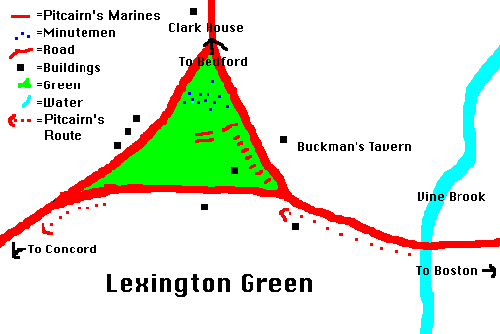
In response to Pitcairn's demands, Capt. Parker ordered his men to disperse. Then a shot rang out - the shot heard around the world Hearing the shot, Major Pitcairn yelled Fire, damn you, fire! The first platoon of Marines fired, but over the heads of the militia. Some of the men in the Militia thought that the troops were firing blanks. However, when a second volley was fired, several of the Militia were killed or wounded. The Lexington Militia are generally depicted as fleeing, not one man shooting back. However, it is known that Parker's men did return fire, though it is unlikely that they held their ground for long. The Militia then retreated into the woods to avoid the British fire. Firing a last volley, the Marines shouted huzzahs as an expression of victory before marching off toward Concord. So ended the first battle in the American Revolutionary War.
When the Militia retreated, eight Americans were dead from musket shot and bayonet wounds, and 10 more were wounded.
Paul Revere, ( there had been reports among the Militia that the goal of the British expedition was to capture Samuel Adams and John Hancock - both of whom were in Lexington) was helping some Militiamen to carry off a trunk load of papers belonging to John Hancock when the British troops led by Major Pitcairn arrived at Lexington. They made a short halt, Revere wrote, when I saw and heard a gun fired which appeared to be a pistol.
This was the "shot heard round the world." Who fired that shot?
Nathaniel Hawthorne (a resident of Concord!), in his story Grandfather's Chair from 1840, mirrors the popular American image:
Was this the battle of Lexington?, asked Charley.
Yes, replied Grandfather; it was so called, because the British, without provocation, had fired upon a party of minute-men, near Lexington meeting-house, and killed eight of them. That fatal volley, which was fired by order of Major Pitcairn, began the war of the Revolution.
Major Pitcairn's report to General Gage:
...when we were advanced within about two miles of Lexington, intelligence was received that about 500 men in arms were assembled, determined to oppose the Kings troops, and retard them in their march. On this intelligence, I mounted my horse, and galloped up to the six Light Companies. When I arrived at the head of the advance Company, two officers came and informed me, that a man of the rebels advanced from those that were assembled, had presented his musket and attempted to shoot them, but the piece flashed in the pan. On this I gave directions to the troops to move forward, but on no account to fire, or even attempt it without orders; when I arrived at the end of the Village, I observed drawn up upon a Green near 200 rebels; when I came within about 100 yards of them, they began to file off towards some stone walls on our right flank. The Light Infantry, observing this, ran after them. I instantly called to the soldiers not to fire, but surround and disarm them, and after several repetitions of those positive orders to the men, not to fire, etc. some of the rebels who had jumped over the wall fired four or five shots at the soldiers, which wounded a man of the Tenth and my horse was wounded in two places, from some quarter or other, and at the same time several shots were fired from a meeting house on our left. Upon this, without any order or regularity, the Light Infantry began a scattered fire, and continued in that situation for some little time, contrary to the repeated orders both of me and the officers that were present.. |
Lieutenant Will Sutherland, a British officer who was near Pitcairn at the time the firing began, left a written record that supports his superior by saying that the colonial troops fired first from behind a stone wall. Other of Pitcairn's officers also supported him in written records, but the men were not always well positioned to see, and there are some variations in their accounts. Lieutenant Thorton, a British officer who was wounded by the patriots perhaps said it best: . . .on our approach they dispersed and soon after firing began, but which party fired first I cannot exactly say, as our troops rushed on, shouting, hazzaing, previous to the firing . . .
The conventional picture of this skirmish is of smartly lined up units on the Lexington Green. Major Pitcairn's report gives another impression - that of chaos and disorder on both sides. This chaos must have contributed, in no small way, to the outcome of the events. We must remember that it was only dawn when these events occurred and that the British had marched all night, and that the Militia had been anxiously waiting all night. Rumours about the British goals (for instance that they planned to jail men like Hancock and Adams) must also have contributed to the anger of the Militiamen. Poor chains of command on both sides surely contributed to the chaos. Parker was leading men that had just arrived, and Pitcairn had only just arrived to his vanguard force within a short time prior to it's arrival at Lexington.
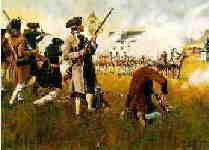


Although it is known that no British soldiers were killed at Lexington Green, Major Pitcairn's horse was shot twice. Some sources say that Pitcairn, who was 52 and portly, fell off and that because of this event his pistols were lost and are now, together with a charming miniature of him, at Hancock-Clarke House, 36 Hancock Street, Lexington Mass. (617-861-0928), as treasured relics of April 19, 1775. Other sources confirm that the horse was wounded at the Battle in Lexington but that on the march back to Lexington, his horse (the same?) , frightened by a sudden volley, threw him off and escaped, obliging him to continue on foot.
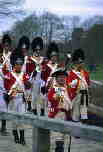
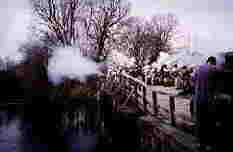

British troops destroyed the supplies found in the center of Concord which had been the goal of their expedition. The colonial militia now posted above the North Bridge in Concord numbered more than 400. They were opposed by about 96 British troops who were stationed at the bridge. As in Lexington, the American commander, Colonel Barrett ordered the militia not to fire till they fired first, then to fire as fast as we could. British soldiers fired the first shots and Major John Buttrick gave the command, Fire, fellow soldiers, for God's sake, fire! The battle lasted less than five minutes. When it was over, two Americans and two British soldiers were dead and a third British soldier would soon die of his wounds. The British soldiers Thomas Smith, Patrick Gray, and James Hall, all of the Light Infantry Company, 4th Regiment are buried at the site of the bridge..
Major Pitcairn also fought at Concord and was alleged at one time - mistakenly - to have fired the first shot. At Concord he labored with Smith to convince the inhabitants that the British meant no injury, but apparently without complete success, since, according to Smith's report, one of the townspeople struck him. There is a persistent tradition--the truth of which is challenged by reliable authority--that he went to Wright's Tavern, and calling for a drink, stirred the brandy in his glass with his finger declaring that he hoped he would stir the Yankee blood so before night.
In the Concord town center, British troops did find and destroy and set fire to military supplies, including gun carriages and barrels of flour. They threw musket balls into the nearby pond and cut down the Liberty Pole. The fire spread to the town meeting house and might have spread beyond if an elderly resident named Martha Moulton had not begged the British officers to put it out.

After the Battles in Lexington and Concord , a running battle back to Boston began. Back in Lexington the British troops were met by reinforcements led by Lord Hugh Percy in command of 1000 fresh troops. Percy also had cannon with him and used it to hold the Colonists off. Even so, the British were fired upon all along their route back to Boston.
This is Longfellows description:
|
.................In the books you have read How the British Regulars fired and fled,--- How the farmers gave them ball for ball, From behind each fence and farmyard wall, Chasing the redcoats down the lane, Then crossing the fields to emerge again Under the trees at the turn of the road, And only pausing to fire and load. |
The full text of Longellow's famous poem of the Midnight Ride of Paul Revere

The Bluff, a small rocky hill along the Battle Road during the running battle back to Boston, presented a significant obstacle to the British while it was held by the colonials. The column appeared trapped until Major Pitcairn sent a detachment to occupy the high ground while the column moved past and reformed.
Some sources maintain that Pitcairn was shot through the leg and removed from command at Fiske Hill on the Bay Road toward Lexington. Fiske Hill was the scene of intense, close-quarter fighting, as British flankers tried to flush out the concealed ambushers shortly after the battle at the North Bridge, during the running battle back to Boston . Others maintain (see above) that his horse threw him off and escaped, obliging him to continue on foot - this may have occurred at Fiske Hill.
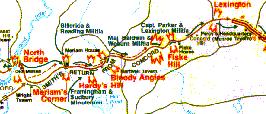
From General Thomas Gage's report on the Battles of Lexington and Concord to the Earl of Dartmouth: on the Return of the Troops they were attacked from all Quarters where any Cover was to be found, from whence it was practicable to annoy them, and they were so fatigued with their March that it was with Difficulty they could keep out their Flanking Partys to remove the Enemy to a Distance, so that they were at length a good deal pressed.
When they arrived back in Boston some 32 hours after the battles, the King's troops had lost 73 killed, 174 wounded and 26 missing while the Colonials lost 49 killed, 39 wounded and 5 prisoners.
From General Thomas Gage's report on the Battles of Lexington and Concord to the Earl of Dartmouth: Major Pitcairn did every thing Men could do, as did all the Officers in general, and the Men behaved with their usual Intrepidity.
